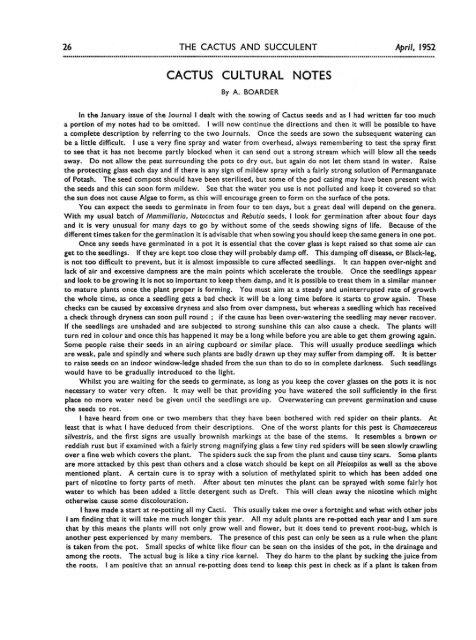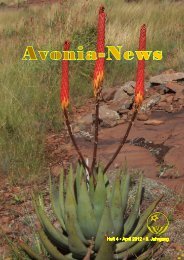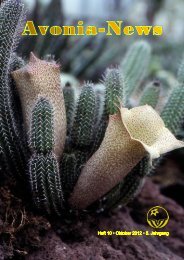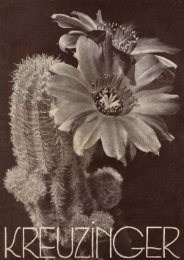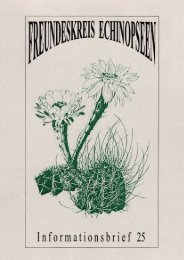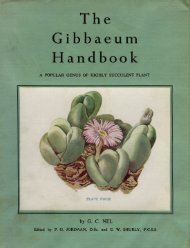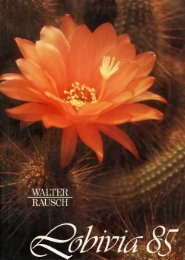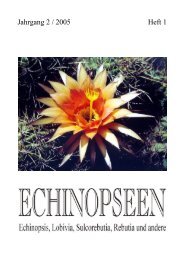VOLUME 14 :: January—October, 1952 Illustrations shown in ...
VOLUME 14 :: January—October, 1952 Illustrations shown in ...
VOLUME 14 :: January—October, 1952 Illustrations shown in ...
Create successful ePaper yourself
Turn your PDF publications into a flip-book with our unique Google optimized e-Paper software.
26 THE CACTUS AND SUCCULENT Apr/7, <strong>1952</strong><br />
CACTUS CULTURAL NOTES<br />
By A. BOARDER<br />
In the January issue of the Journal I dealt with the sow<strong>in</strong>g of Cactus seeds and as I had written far too much<br />
a portion of my notes had to be omitted. I will now cont<strong>in</strong>ue the directions and then it will be possible to have<br />
a complete description by referr<strong>in</strong>g to the two Journals. Once the seeds are sown the subsequent water<strong>in</strong>g can<br />
be a little difficult. I use a very f<strong>in</strong>e spray and water from overhead, always remember<strong>in</strong>g to test the spray first<br />
to see that it has not become partly blocked when it can send out a strong stream which will blow all the seeds<br />
away. Do not allow the peat surround<strong>in</strong>g the pots to dry out, but aga<strong>in</strong> do not let them stand <strong>in</strong> water. Raise<br />
the protect<strong>in</strong>g glass each day and if there is any sign of mildew spray with a fairly strong solution of Permanganate<br />
of Potash. The seed compost should have been sterilised, but some of the pod cas<strong>in</strong>g may have been present with<br />
the seeds and this can soon form mildew. See that the water you use is not polluted and keep it covered so that<br />
the sun does not cause Algae to form, as this will encourage green to form on the surface of the pots.<br />
You can expect the seeds to germ<strong>in</strong>ate <strong>in</strong> from four to ten days, but a great deal will depend on the genera.<br />
With my usual batch of Mammillaria, Notocactus and Rebutia seeds, I look for germ<strong>in</strong>ation after about four days<br />
and it is very unusual for many days to go by without some of the seeds show<strong>in</strong>g signs of life. Because of the<br />
different times taken for the germ<strong>in</strong>ation it is advisable that when sow<strong>in</strong>g you should keep the same genera <strong>in</strong> one pot.<br />
Once any seeds have germ<strong>in</strong>ated <strong>in</strong> a pot it is essential that the cover glass is kept raised so that some air can<br />
get to the seedl<strong>in</strong>gs. If they are kept too close they will probably damp off. This damp<strong>in</strong>g off disease, or Black-leg,<br />
is not too difficult to prevent, but it is almost impossible to cure affected seedl<strong>in</strong>gs. It can happen over-night and<br />
lack of air and excessive dampness are the ma<strong>in</strong> po<strong>in</strong>ts which accelerate the trouble. Once the seedl<strong>in</strong>gs appear<br />
and look to be grow<strong>in</strong>g it is not so important to keep them damp, and it is possible to treat them <strong>in</strong> a similar manner<br />
to mature plants once the plant proper is form<strong>in</strong>g. You must aim at a steady and un<strong>in</strong>terrupted rate of growth<br />
the whole time, as once a seedl<strong>in</strong>g gets a bad check it will be a long time before it starts to grow aga<strong>in</strong>. These<br />
checks can be caused by excessive dryness and also from over dampness, but whereas a seedl<strong>in</strong>g which has received<br />
a check through dryness can soon pull round ; if the cause has been over-water<strong>in</strong>g the seedl<strong>in</strong>g may never recover.<br />
If the seedl<strong>in</strong>gs are unshaded and are subjected to strong sunsh<strong>in</strong>e this can also cause a check. The plants will<br />
turn red <strong>in</strong> colour and once this has happened it may be a long while before you are able to get them grow<strong>in</strong>g aga<strong>in</strong>.<br />
Some people raise their seeds <strong>in</strong> an air<strong>in</strong>g cupboard or similar place. This will usually produce seedl<strong>in</strong>gs which<br />
are weak, pale and sp<strong>in</strong>dly and where such plants are badly drawn up they may suffer from damp<strong>in</strong>g off. It is better<br />
to raise seeds on an <strong>in</strong>door w<strong>in</strong>dow-ledge shaded from the sun than to do so <strong>in</strong> complete darkness. Such seedl<strong>in</strong>gs<br />
would have to be gradually <strong>in</strong>troduced to the light.<br />
Whilst you are wait<strong>in</strong>g for the seeds to germ<strong>in</strong>ate, as long as you keep the cover glasses on the pots it is not<br />
necessary to water very often. It may well be that provid<strong>in</strong>g you have watered the soil sufficiently <strong>in</strong> the first<br />
place no more water need be given until the seedl<strong>in</strong>gs are up. Overwater<strong>in</strong>g can prevent germ<strong>in</strong>ation and cause<br />
the seeds to rot.<br />
I have heard from one or two members that they have been bothered with red spider on their plants. At<br />
least that is what I have deduced from their descriptions. One of the worst plants for this pest is Chamaecereus<br />
silvestris, and the first signs are usually brownish mark<strong>in</strong>gs at the base of the stems. It resembles a brown or<br />
reddish rust but if exam<strong>in</strong>ed with a fairly strong magnify<strong>in</strong>g glass a few t<strong>in</strong>y red spiders will be seen slowly crawl<strong>in</strong>g<br />
over a f<strong>in</strong>e web which covers the plant. The spiders suck the sap from the plant and cause t<strong>in</strong>y scars. Some plants<br />
are more attacked by this pest than others and a close watch should be kept on all Pleiospilos as well as the above<br />
mentioned plant. A certa<strong>in</strong> cure is to spray with a solution of methylated spirit to which has been added one<br />
part of nicot<strong>in</strong>e to forty parts of meth. After about ten m<strong>in</strong>utes the plant can be sprayed with some fairly hot<br />
water to which has been added a little detergent such as Dreft. This will clean away the nicot<strong>in</strong>e which might<br />
otherwise cause some discolouration.<br />
I have made a start at re-pott<strong>in</strong>g all my Cacti. This usually takes me over a fortnight and what with other jobs<br />
I am f<strong>in</strong>d<strong>in</strong>g that it will take me much longer this year. All my adult plants are re-potted each year and I am sure<br />
that by this means the plants will not only grow well and flower, but it does tend to prevent root-bug, which is<br />
another pest experienced by many members. The presence of this pest can only be seen as a rule when the plant<br />
is taken from the pot. Small specks of white like flour can be seen on the <strong>in</strong>sides of the pot, <strong>in</strong> the dra<strong>in</strong>age and<br />
among the roots. The actual bug is like a t<strong>in</strong>y rice kernel. They do harm to the plant by suck<strong>in</strong>g the juice from<br />
the roots. I am positive that an annual re-pott<strong>in</strong>g does tend to keep this pest <strong>in</strong> check as if a plant is taken from


